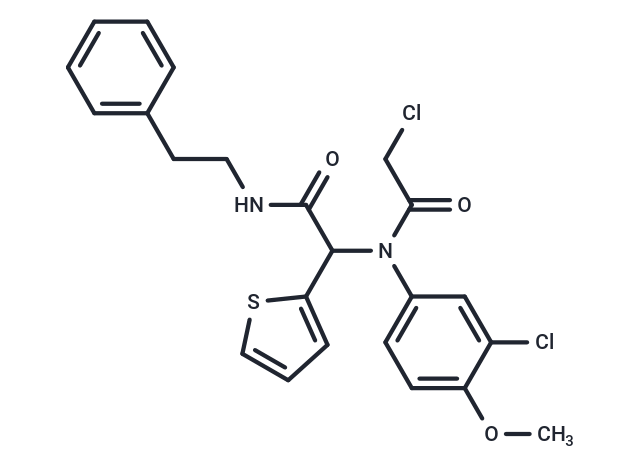Shopping Cart
Remove All Your shopping cart is currently empty
Your shopping cart is currently empty
ML162 is a covalent glutathione peroxidase 4 (GPX4) inhibitor that induces ferroptosis. ML162 has antitumor activity and selectively inhibits cell lines expressing mutant RAS oncogenes.

| Pack Size | Price | USA Warehouse | Global Warehouse | Quantity |
|---|---|---|---|---|
| 1 mg | $38 | In Stock | In Stock | |
| 5 mg | $82 | In Stock | In Stock | |
| 10 mg | $118 | In Stock | In Stock | |
| 25 mg | $239 | In Stock | In Stock | |
| 50 mg | $372 | In Stock | In Stock | |
| 100 mg | $519 | In Stock | In Stock | |
| 200 mg | $746 | In Stock | In Stock | |
| 1 mL x 10 mM (in DMSO) | $88 | In Stock | In Stock |
| Description | ML162 is a covalent glutathione peroxidase 4 (GPX4) inhibitor that induces ferroptosis. ML162 has antitumor activity and selectively inhibits cell lines expressing mutant RAS oncogenes. |
| In vitro | METHODS: Human lung cancer cells A549 were pretreated with ML162 (0.1-15 µM) for 4-24 h, and TXNRD1 activity was measured with the RX1 activity probe. RESULTS: RX1 signaling was significantly inhibited dose-dependently at ML162 concentrations of 0.5 µM or higher. there was also a fairly rapid onset of concentration-dependent inhibition of cellular TXNRD1 activity, and incubation with 1 µM or higher ML162 treatment for 4 h was sufficient to inhibit RX1 signaling. mL162 effectively inhibited cellular TXNRD1 activity. ML162 effectively inhibits cellular TXNRD1 activity. ML162 effectively inhibited cellular TXNRD1 activity.[1] METHODS: Melanoma cells A2058 and A375 were pretreated with ferrostatin (10 µM), Z-VAD-FMK (10 µM), or necrosulfonamide (0.5 µM) for 24 h. Cell viability was assayed after ML162 (1-16 µM) treatment. RESULTS: ML162 caused cell death in a dose-dependent manner in the A2058 and A375 melanoma cell lines, which could be reversed by ferrostatin-1, a ferritin-specific inhibitor, but not by Z-VAD-FMK, an inhibitor of apoptosis, or necrosulfonamide, an inhibitor of necrotic apoptosis. [2] |
| In vivo | METHODS: To detect anti-tumor activity in vivo, ML162 (40 mg/kg once daily) and anti-PD-1 antibody (200 µg every three days) were intraperitoneally injected into BALB/c mice bearing TS/A tumors once daily for two weeks. RESULTS: The combination of GPX4 inhibitor and anti-PD-1 antibody significantly inhibited tumor growth compared with monotherapy. The combination therapy did not result in additional immune cell infiltration compared to monotherapy, but the combination therapy induced a significant immune response with an increased proportion of PRF1+CD8+ T cells and GZMB+CD8+ T cells. [3] |
| Molecular Weight | 477.4 |
| Formula | C23H22Cl2N2O3S |
| Cas No. | 1035072-16-2 |
| Smiles | COc1ccc(cc1Cl)N(C(C(=O)NCCc1ccccc1)c1cccs1)C(=O)CCl |
| Relative Density. | 1.342 g/cm3 (Predicted) |
| Storage | Powder: -20°C for 3 years | In solvent: -80°C for 1 year | Shipping with blue ice/Shipping at ambient temperature. | |||||||||||||||||||||||||||||||||||
| Solubility Information | DMSO: 247 mg/mL (517.39 mM), Sonication is recommended. | |||||||||||||||||||||||||||||||||||
| In Vivo Formulation | 10% DMSO+40% PEG300+5% Tween 80+45% Saline: 0.48 mg/mL (1.01 mM), Solution. Please add the solvents sequentially, clarifying the solution as much as possible before adding the next one. Dissolve by heating and/or sonication if necessary. Working solution is recommended to be prepared and used immediately. The formulation provided above is for reference purposes only. In vivo formulations may vary and should be modified based on specific experimental conditions. | |||||||||||||||||||||||||||||||||||
Solution Preparation Table | ||||||||||||||||||||||||||||||||||||
DMSO
| ||||||||||||||||||||||||||||||||||||
| Size | Quantity | Unit Price | Amount | Operation |
|---|

Copyright © 2015-2025 TargetMol Chemicals Inc. All Rights Reserved.